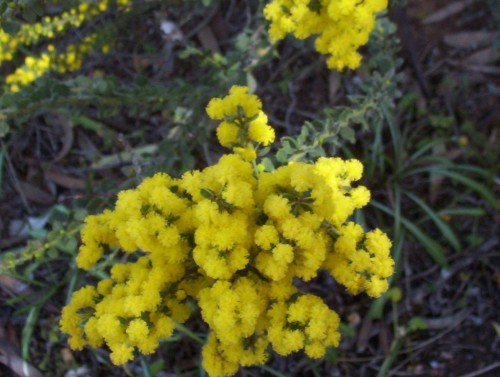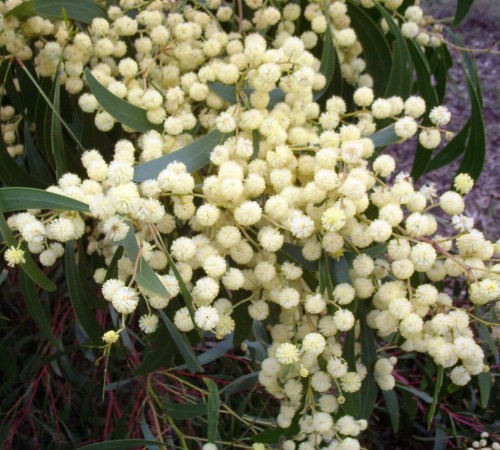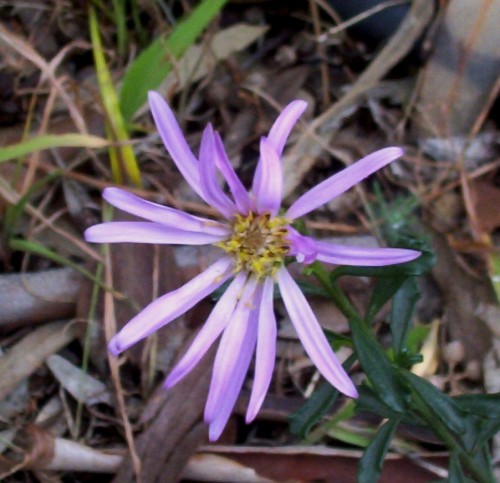Acacia acinacea (Gold Dust Wattle)
This wattle has just about finished now. I was able to get a few photos this year. It is another of the local Acacias and its common name is indicative of the colour. Mine grows at the base of mallees and gets morning sun. As a result it is about 70cm tall. It can get to one and a half metres. Rather a spindly plant with widely arching branches but each branch is smothered in gold flowers. I look forward to this one flowering each year.
I do like wattles. Many people complain about them and there is no doubt that some have an overpowering perfume. There are so many that do not that there is bound to be one that will suit a garden. So many are also frost, drought and lime tolerant. When the flowers have finished they make a good background to other plants when they are in flower.
Acacia rhetinocarpa
Acacia rhetinocarpa is a rare wattle which is endangered in South Australia. I have a plant given to me many years ago. Every year I miss out on the seed as the pods seem to split quickly and seed has gone before I get a chance to collect them. Seeing the abundance of the flowers this year hopefully means that seed will set and if I am organised I will try to put a stocking bag over a few branchlets to catch the seed.It is a pretty ornamental wattle.
Members of the local Australian Plant Society used to check on a small colony of plants near here. The plants grew in a position where they received some water run-off from the road. Ferries McDonald Conservation Park in South Australia has some colonies which were protected by the Field Naturalists Society.
My plant is only about a metre tall and wide. They can get to one and a half metres but mine is growing at the base of some mallee trees and has root competition.This is another tough drought, frost and lime tolerant plant.
Acacia pycnantha (Golden Wattle)
These are making a great splash of colour around the country side now. We have a couple and when the seed pods set and seed is ripening, the galahs have a great feed from them. Unfortunately it does not deter them from the almond trees. One day I would like to have just one feed from the tree, instead of these freeloaders getting the lot.
However I have found a few trees that have cream flowers rather than the golden yellow balls. The trees still seem to have the same form, although here they don’t grow as tall as they might in a higher rainfall area. In a good season we do get seed germinating near the parent tree. This winter has been so dry that it won’t happen this year.
In general Acacias make great plants for windbreaks. Those trees that get artificail watering from, say, a sprinkler on a lawn, don’t seem to live as long as those in the bush.
Olearia magniflora
I do like daisies. All sorts of daisies, including those that are not native to Australia. It was with excitement that I noticed the dark mauve flowers on my small Olearia magniflora, with some buds still to open. Mine doesn’t do as well as those we saw along the side of the road on the way back to Meribah in SA, after an excursion in Murray-Sunset National Park in Victoria. We call this park ‘Sunset’ as it was known by that name to the locals near where husband lived as a child. The Victorian Border could be seen from the property.
Olearia magniflora is a small shrub to about a metre high and half a metre wide. It seems to grow in the dappled shade of mallee trees. Even though this is growing in a relatively tough environment, they are not the easiest to grow in a garden situation. Many of these plants resent too much moisture and exposure to wild winds. Hardy is a word that has different meanings to people depending on where they live.
Eremophila complanata
Eremophila complanata is another of those tough lime and drought tolerant plants. It is in full flower at the moment making a lovely splash of colour.
Before using Australian Natives as cut flowers became more widely practised, we knew that this one kept for two weeks in a vase. It is still not on any published lists of plants suitable for the cut flower trade.
When our local group of the Australian Plant Society used to organise a Spring Flower Show we got to know how many species behaved when cut for display.
Eremophila complanata is a shrub to about one and a half metres, by nearly a metre wide. It would be a bit smaller if I took cuts from the bush regularly. It becomes straggly if not trimmed after flowering.




